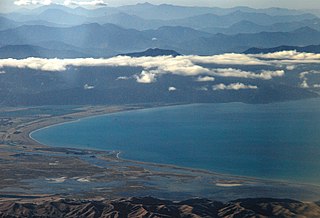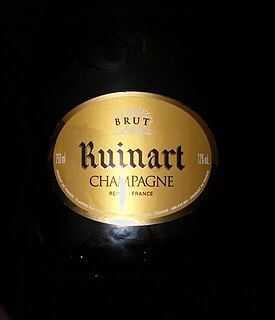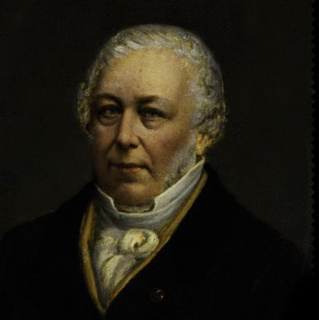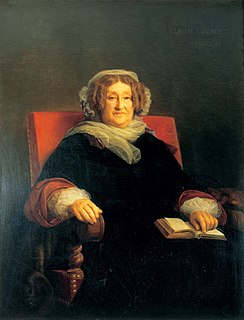Related Research Articles

Champagne is a French sparkling wine. Many people use the term Champagne as a generic term for sparkling wine, but in the EU and some other countries, it is illegal to label any product Champagne unless it came from the Champagne wine region of France and is produced under the rules of the appellation. This alcoholic drink is produced from specific types of grapes grown in the Champagne region following rules that demand, among other things, specific vineyard practices, sourcing of grapes exclusively from designated places within the Champagne region, specific grape-pressing methods and secondary fermentation of the wine in the bottle to cause carbonation.

The Champagne wine region is a wine region within the historical province of Champagne in the northeast of France. The area is best known for the production of the sparkling white wine that bears the region's name. EU law and the laws of most countries reserve the term "Champagne" exclusively for wines that come from this region located about 160 kilometres (100 miles) east of Paris. The viticultural boundaries of Champagne are legally defined and split into five wine-producing districts within the historical province: Aube, Côte des Blancs, Côte de Sézanne, Montagne de Reims, and Vallée de la Marne. The towns of Reims and Épernay are the commercial centers of the area. Reims is famous for its cathedral, the venue of the coronation of the French Kings and a UNESCO World Heritage Site.

Sparkling wine is a wine with significant levels of carbon dioxide in it, making it fizzy. While the phrase commonly refers to champagne, EU countries legally reserve that term for products exclusively produced in the Champagne region of France. Sparkling wine is usually either white or rosé, but there are examples of red sparkling wines such as the Italian Brachetto, Bonarda and Lambrusco, Australian sparkling Shiraz, and Azerbaijani "Pearl of Azerbaijan" made from Madrasa grapes. The sweetness of sparkling wine can range from very dry brut styles to sweeter doux varieties.

Dom Pérignon is a brand of vintage Champagne produced by the Champagne house of Moët & Chandon, and it serves as that house's prestige Champagne. It is named after Dom Pérignon, a Benedictine monk who was an important quality pioneer for Champagne wine but who, contrary to popular myths, did not discover the Champagne method for making sparkling wines.
Louis Roederer is a producer of champagne based in Reims, France. Founded in 1776, it was inherited and renamed by Louis Roederer in 1833. It remains today as one of the only still independent and family-run maisons de champagne. Over 3.5 million bottles of Louis Roederer champagne are shipped each year to more than 100 countries.
Heidsieck & Co "Monopole" is a champagne house located in the Champagne region of France.

Veuve Clicquot Ponsardin is a French Champagne house based in Reims, specializing in premium products. It was founded in 1772 by Philippe Clicquot and is one of the largest champagne houses in the world. Madame Clicquot is credited with major breakthroughs, creating the first known vintage champagne in 1810, and inventing the riddling table process to clarify champagne in 1816. In 1818, she invented the first known blended rosé champagne by blending still red and white champagne wines. This process is still used today by the majority of champagne producers.

Cloudy Bay Vineyards is a winery based in the Marlborough wine region of New Zealand, with vineyards in both Marlborough and Central Otago. Established in 1985 by David Hohnen as one of the earliest wineries founded in Marlborough, it was acquired by Champagne house Veuve Clicquot in 2003 and is now a LVMH brand.

Bollinger is a French Champagne house, a producer of sparkling wines from the Champagne region. They produce several labels of Champagne under the Bollinger name, including the vintage Vieilles Vignes Françaises, Grande Année and R.D. as well as the non-vintage Special Cuvée. Founded in 1829 in Aÿ by Hennequin de Villermont, Paul Renaudin and Jacques Bollinger the house continues to be run by members of the Bollinger family. In Britain Bollinger Champagnes are affectionately known as "Bolly".

Ruinart is the oldest established Champagne house, exclusively producing champagne since 1729. Founded by Nicolas Ruinart in the Champagne region in the city of Reims, the house is today owned by LVMH Moët Hennessy Louis Vuitton SA.

Jean-Rémy Moët (1758–1841) was a French vintner and merchant seaman who helped bring the Champagne house of Moët et Chandon to international prominence. He inherited the house from his grandfather and founder Claude Moët.

Charles Camille Heidsieck (1822–1893) was a French Champagne merchant who founded the Champagne firm Charles Heidsieck in 1851. He is credited with popularizing Champagne in the United States and was known as "Champagne Charlie" during his stay.
Canard-Duchêne is a Champagne house founded in 1868 and currently part of the Thiénot group, owner of its own label Champagne Thiénot, plus Joseph Perrier and Marie Stuart.
Henriot is a Champagne producer based in the Reims region of Champagne. The house, founded in Reims 1808, produces both vintage and non-vintage cuvée. Henriot has been under family ownership since 1994 when Joseph Henriot left Veuve Clicquot to manage the estate.

The history of Champagne has seen the wine evolve from being a pale, pinkish still wine to the sparkling wine now associated with the region. The Romans were the first to plant vineyards in this area of northeast France, with the region being cultivated by at least the 5th century, possibly earlier. When Hugh Capet was crowned King of France in 987 at the cathedral of Reims, located in the heart of the region, he started a tradition that brought successive monarchs to the region—with the local wine being on prominent display at the coronation banquets. The early wine of the Champagne region was a pale, pinkish wine made from Pinot noir.

Grower Champagnes are Champagnes produced by the estate that owns the vineyards where the grapes are grown. Récoltant-Manipulant is the term in French, and Grower Champagnes can be identified by "RM" on the wine label. While large Champagne houses such as Mumm, Moët et Chandon and Veuve Clicquot may use grapes from as many as 80 different vineyards in the Champagne region to create a consistent house style, Grower Champagnes tend to be more terroir-focused, sourced from a single vineyard or closely located vineyards around a village, and made with grapes which vary with each vintage. Today there are over 19,000 independent growers in the Champagne region, accounting for nearly 88% of vineyard land in the region; around 5,000 of these growers produce wine from their own grapes. Of the Champagne imported into the US in 2014, only 5% was Grower Champagne.

Comet vintages are years during which an astronomical event, involving generally a "Great Comet", occurs prior to harvest. Throughout the history of wine, winemakers have attributed successful vintages and ideal weather conditions to the unexplained effects caused by the comets. Some of the most heralded vintages in the last couple of centuries—such as the 1811, 1826, 1839, 1845, 1852, 1858, 1861, 1985, and 1989 vintages—have coincided with a notable appearance of a comet. There is no scientific basis for any effect of comets on viticulture, but the term nevertheless remains in use.
Jacquesson & Fils is a Champagne producer based in the Dizy region of Champagne. The house was founded in Châlons-sur-Marne in 1798 by Memmie Jacquesson. The house makes the claim it is the oldest independent Champagne house.

Madame Clicquot, née Ponsardin, Widow Clicquot or Veuve Clicquot, known as the "Grande Dame of Champagne", was a French businesswoman who took on her husband's wine business when widowed at 27. Under her ownership, and her skill with wine, the company developed early champagne using a novel technique. The brand and company of Veuve Clicquot Ponsardin still bears her name.
The Föglö wreck is a shipwreck of a 19th-century two-masted schooner lying in the waters off Föglö near the Åland Islands in Finland. It became famous in the summer of 2010 as several bottles of world's oldest drinkable champagne were raised from the wreck.
References
- ↑ Hugh Johnson, Vintage: The Story of Wine (New York: Simon and Schuster 1989), p. 334. ISBN 0-671-68702-6.
- ↑ Don and Petie Kladstrup, Champagne: How the World’s Most Glamorous Wine Triumphed Over War and Hard Times (New York: William Morrow, 2005), p. 81. ISBN 0-06-073792-1.
- ↑ D. & P. Kladstrup, Champagne, p. 82.
- 1 2 D. & P. Kladstrup, Champagne, p. 83–84.
- ↑ Johnson, Vintage, p. 335.